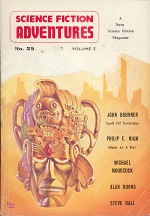Times Without Numbers
- by John Brunner
- Short Story
- Science Fiction
- Adults
- Definite Time Travel
- English
- “Times Without Numbers” by John Brunner, in Science Fiction Adventure (25, March 1962).
In an alternate Spanish-dominated 20th century, Don Miguel Navarro is a time traveler in the western world’s Society of Time who are locked in a time-travel cold war with the Confederacy of the East, not to mention their task of tracking down various time crimes.
I try to avoid major spoilers (stop reading now, if you wish), but the reason that Don Miguel ends up in a world without time travel is one that I thought of (long after Brunner) based on fixed-points in mathematics. That idea alone gives the story an extra star.
The original three stories appeared in three consecutive issues of Science Fiction Adventure, and they were later fixed up into a short novel that was subsequently expanded. It’s the expanded version that I read from the CU library.
I try to avoid major spoilers (stop reading now, if you wish), but the reason that Don Miguel ends up in a world without time travel is one that I thought of (long after Brunner) based on fixed-points in mathematics. That idea alone gives the story an extra star.
The original three stories appeared in three consecutive issues of Science Fiction Adventure, and they were later fixed up into a short novel that was subsequently expanded. It’s the expanded version that I read from the CU library.
It wasn’t only the embarrassing experience of being shown off around the hall by her—as it were, a real live time-traveller, exclamation point, in the same tone of voice as one would say, “A real live tiger!” That happened too often for members of the Society of Time not to have grown used to it; there were, after all, fewer than a thousand of them in the whole of the Empire.

Variants
(1)
- “Times Without Numbers” by John Brunner, in Science Fiction Adventure (25, March 1962).
